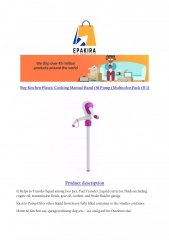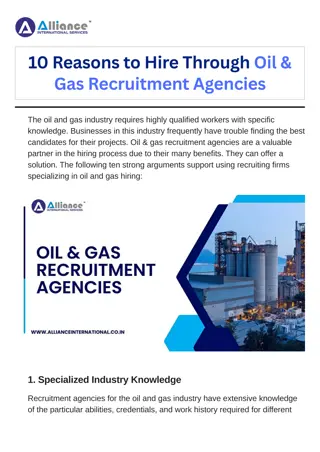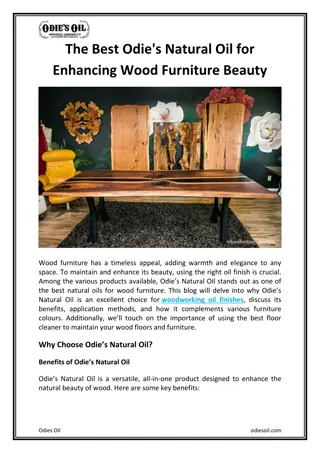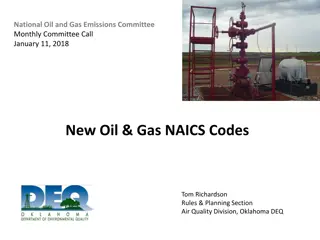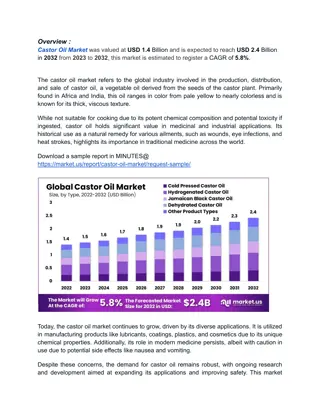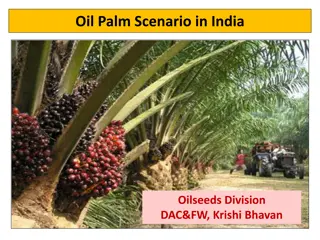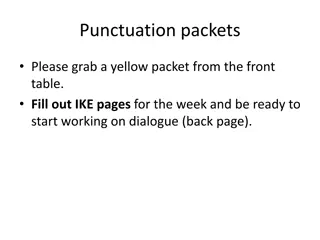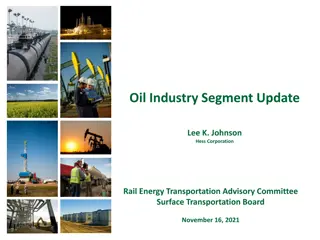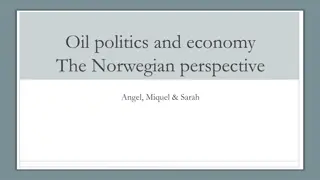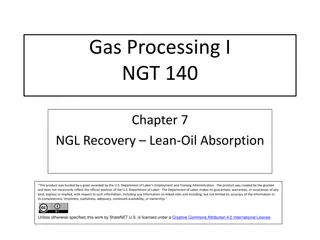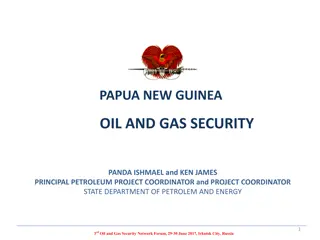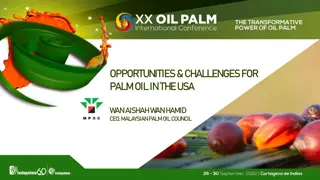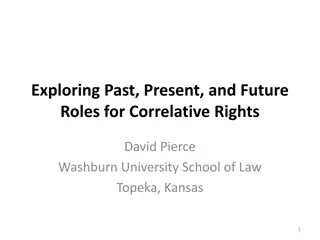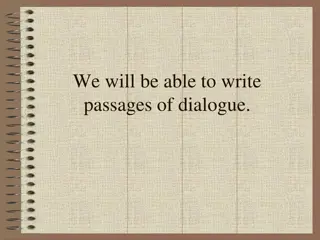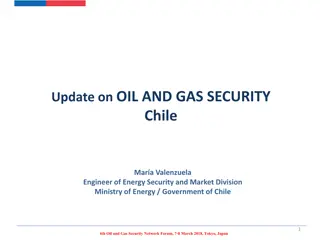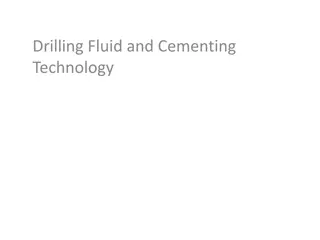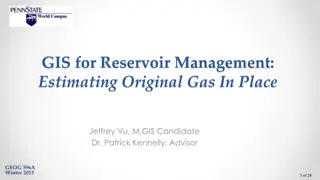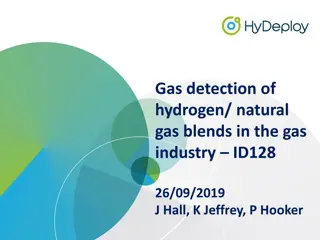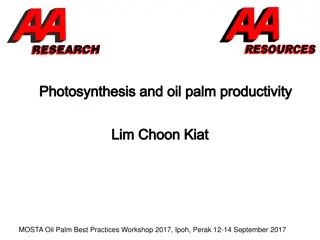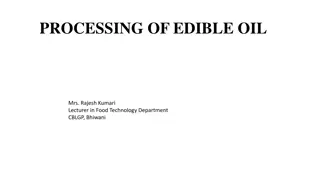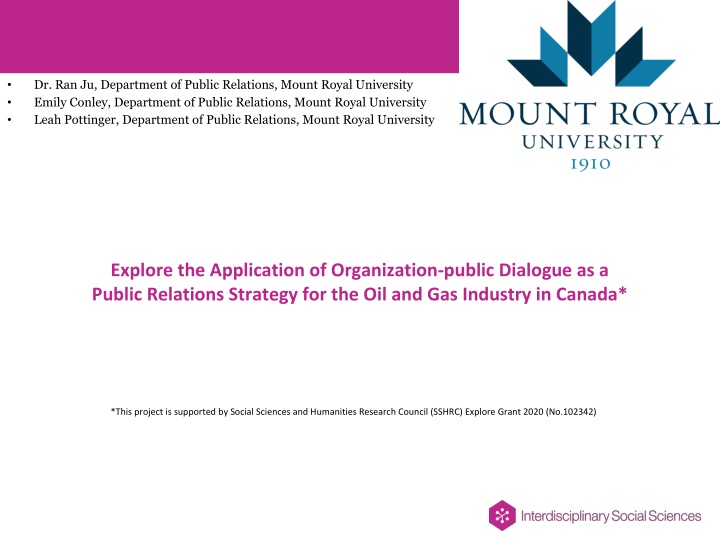
Organization-Public Dialogue in Canadian Oil and Gas Industry
This research project delves into the application of organization-public dialogue as a strategic approach in the Canadian oil and gas sector. By investigating how companies in this industry engage in dialogue and examining ways to enhance their practices, the study aims to improve stakeholder relationships. Through an in-depth analysis of dialogical communication, the project seeks to address the unique challenges faced by the oil and gas companies in Canada.
Download Presentation

Please find below an Image/Link to download the presentation.
The content on the website is provided AS IS for your information and personal use only. It may not be sold, licensed, or shared on other websites without obtaining consent from the author. If you encounter any issues during the download, it is possible that the publisher has removed the file from their server.
You are allowed to download the files provided on this website for personal or commercial use, subject to the condition that they are used lawfully. All files are the property of their respective owners.
The content on the website is provided AS IS for your information and personal use only. It may not be sold, licensed, or shared on other websites without obtaining consent from the author.
E N D
Presentation Transcript
Dr. Ran Ju, Department of Public Relations, Mount Royal University Emily Conley, Department of Public Relations, Mount Royal University Leah Pottinger, Department of Public Relations, Mount Royal University Explore the Application of Organization-public Dialogue as a Public Relations Strategy for the Oil and Gas Industry in Canada* *This project is supported by Social Sciences and Humanities Research Council (SSHRC) Explore Grant 2020 (No.102342)
Background Organization-public dialogue (OPD), defined as an ethical communication between an organization and its public that emphasizes mutual understanding, respect, and acceptance (Chen et al., 2020, Kent & Taylor, 2002), has become one of the major areas in PR research and practices (Ao & Huang, 2020). As a controversial sector, the oil and gas industry in Canada serves as a unique context to revisit and develop the theory and practice of dialogue for two reasons: 1.Canadian society is highly community-based, and a significant focus of PR efforts in Canada is on community relationships (Likely, 2009). Thus, it provides the ideal environment for developing dialogical communication between organizations and the public, compared to marketing-orientated environments such as PR in the U.S. (Kelleher & Males, 2020). 2. Although the oil and gas industry is a pillar industry in Canada, contributing many job opportunities and economic benefits (Government of Canada, 2020), it faces much controversy and contention due to its disturbance of the natural environment and the consequential repercussions (Rand, 2014) and dialogic communication can help this industry to mitigate this problem.
Dialogue In the field of public relations, the concept of dialogue/dialogical communication was introduced by Grunig and Hunt (1984) that in two-way symmetric communication, an organization is in dialogue with publics. The concept was further popularized by Pearson (1989) as an ethical process of communication to maintain relationships between organizations and publics. Kent and Taylor (1998) described dialogue as a particular type of relational interaction (p.323) and suggested five features of dialogue (Kent & Taylor, 2002): 1. Mutuality: Recognition of organization-public relationships 2. Propinquity: Temporality and spontaneity of interactions with publics 3. Empathy: Supportiveness and confirmation of public goals and interests 4. Risk: Willingness to interact with individuals and publics on their terms 5. Commitment: the extent to which an organization gives itself over to dialogue, interpretation, and understanding in its interactions with publics.
Research Questions Research Questions How did oil and gas companies use dialogue in their daily PR practices? In what way did their practices meet the features of dialogue? In what way can oil and gas companies improve their dialogical PR practices to improve the relationships with stakeholders?
Method: In-depth Semi-structured Interview Participants and Interviews: 21 practitioners working in oil and gas companies in Canada holding various communication-related positions (entry-level, advisory, mid-manager, senior and executive). On average, participants had 12 years of experience in the oil and gas industry and had held the current position for 2.5 years. Interviews lasted 40-60 minutes and were audio-recorded and transcribed. Data analysis: The coding process included open coding, axial coding, and selective coding (Corbin & Strauss, 2008). Through the on-going coding process, we developed preliminary themes from the data (Salda a, 2013) to answer research questions.
Results: RQ1 How did oil and gas companies use dialogue in their daily PR practices? Major Stakeholders Codes Codes Media Types Customers Employees Landowners Suppliers and Contractors Investors Communities of operation General Public Social media Website Print/TV Email In-person events (i.e., site visit, townhall meetings) Virtual meetings/events Over the phone Reporting with direct feedback ESG/CSR reporting Teaching energy literacy Intranet Executives Appointed committees Owned Earned Paid shared
Results: RQ2 In what way did their practices meet the features of dialogue? Based on the data we collected, we made judgement about if the five features were met, and we used some quotes from the participants to illustrate. Mutuality: met [It is important to] have a conversation directly and gather feedback from the source and from even a representative of the community. In order to do that, it's really about engagement. It's about that kind of personal opportunity to allow people to air their views and engage in dialogue that leads to better understanding. Propinquity: met I would definitely say that with with COVID it was a huge shift, because in person, it's easier to tell what people's emotions are and how they're feeling about the characters that they're presenting. I've noticed is that we needed to be more deliberate in our communication and ensure that we understand the emotion and how people are feeling prior to sending out any communication so that we are aligned with people. That's one big thing that has definitely been impacted by COVID is just being more thoughtful in our communication, wording, language strategy, timing and the medium we use.
Results: RQ2 In what way did their practices meet the features of dialogue? Empathy: met First and foremost, ESG (environmental, social and governance) is at the forefront of every energy conversation right now, as it should be. We have the responsibility to reduce our emissions we want to leave a healthier planet for those after us. Socially, we have our Community Investment, Indigenous Relations, community, landowner and recreational group relationships. With the governance standpoint we have gender equality, as we have a goal to have 40 per cent women in the workplace by 2030 is. Those kind of changes you need to have. Risk: not met [O&G companies] had made the strategic decision not to go into social media until very late in the game because they wanted to stay quiet. There is also an overhead cost. You can't have a PR firm, taking care of your day to day social media it's just not going to resonate it won't be authentic and transparent. However, the world wanted [O&G companies] on social media. There's too many companies that don't play the social media world now. Commitment: semi-met I know [my company] in the past has been very reluctant to have those open and transparent conversations. Now moving forward, especially with new leadership. that's definitely our main focus moving forward and having those really transparent conversations. That has been huge with aligning with public relations because when you think of public relations you, you tend to gravitate towards developing relationships right and developing important conversations and transparency and moving forward.
Results: RQ 3 In what way can oil and gas companies improve their dialogical PR practices to improve the relationships with stakeholders? Common Key Words: Vulnerability Transparency Authenticity Further research Commitment Trustworthiness Openness Continuity
Practical Implications Transparency: live by your values as an organization to openly align all messaging with the business strategy Authenticity: being true to the organizations mission in all messaging as a means of reputation management Vulnerability: create emotionally driven dialogue that the public can relate to via owned media; such as the website and social media channels Further Research: to understand how the organization is viewed and the important stakeholders trying to be reached. Can be achieved through reputational studies
Practical Implications Continued Trustworthiness: own the organization s narrative, even if it isn t a legal requirement. This will build trust and aid in avoiding misinformation Commitment: to constant tailored communication with important stakeholders. With an emphasis on internal messaging to enhance employee advocacy Continuity: creating processes to establishing a unified voice and dialogue Openness: share the oil and gas story to educate the public and improve transparency by using social media channels available to the organization
References Ao, S. H., & Huang, Q. S. (2020). A systematic review on the application of dialogue in public relations to informationcommunication technology-based platforms: Comparing English and Chinese contexts. Public relations review, 46(1), 101814. Bohm, D. (2010). On dialogue. New York, NY: Routledge Classics. Chen, Y. R. R., Hung-Baesecke, C. J. F., & Chen, X. (2020). Moving forward the dialogic theory of public relations: Concepts, methods and applications of organization-public dialogue. Public Relations Review, 46(1), 101878. Cheng, Y. (2020). The social-mediated crisis communication research: Revisiting dialogue between organizations and publics in crises of China. Public relations review, 46(1), 101769. Daymon, C., & Holloway, I. (2011). Qualitative research methods in public relations and marketing communications. London, UK: Routledge. Delannon, N., Raufflet, E., & Baba, S. (2016). Corporate community engagement strategies and organizational arrangements: A multiple case study in Canada. Journal of Cleaner Production, 129, 714-723. Dewey, J. (1916). Democracy and education. New York, NY: Macmillan. Dhanesh, G. S. (2017). Putting engagement in its PRoper place: State of the field, definition and model of engagement in public relations. Public Relations Review, 43(5), 925-933. Freire, P. (1996). Pedagogy of the oppressed. London: Penguin. Gibbs, J. L., Rozaidi, N. A., & Eisenberg, J. (2013). Overcoming the ideology of openness : Probing the affordances of social media for organizational knowledge sharing. Journal of Computer-Mediated Communication, 19 (1), 102 120. Golob, U., & Podnar, K. (2011). Corporate social responsibility communication and dialogue. In O. Ihlen, J. L. Bartlett, & S. May (Eds.), The handbook of communication and corporate social responsibility (231-251). John Wiley & Sons, Inc. Government of Canada (2020, October 06). Energy and the economy. https://www.nrcan.gc.ca/science-data/data- analysis/energy-data-analysis/energy-facts/energy-and-economy/20062 Kelleher, T., & Males, A. M. (2020). Public relations (Canadian Edition). Ontario: Oxford University Press Kent, M. L. (2017). Principles of dialogue and the history of dialogic theory in public relations. In X. Chen (Ed.). Prospect of public relations science. Beijing, China: Peking: University Press.
References Kent, M. L., & Taylor, M. (2002). Toward a dialogic theory of public relations. Public relations review, 28(1), 21-37. Likely, F. (2009). A different country, a different public relations: Canadian PR in the North American context. In K. Sriramesh & D. Vercic (Eds.), The global public relations handbook: Theory, research and practice (674-775). Routledge. Medaglia, R., & Zhu, D. (2017). Public deliberation on government-managed social media: A study on Weibo users in China. Government Information Quarterly, 34(3), 533 544. Men, L. R., Tsai, W. H. S., Chen, Z. F., & Ji, Y. G. (2018). Social presence and digital dialogic communication: Engagement lessons from top social CEOs. Journal of Public Relations Research, 30(3), 83-99. Merriam, S. B., & Tisdell, E. J. (2015). Qualitative research: A guide to design and implementation. John Wiley & Sons. Moreno, A., Navarro, C., Tench, R., & Zerfass, A. (2015). Does social media usage O. D. W. Hargie, M. Taylor, and M. Toledano (Eds.), International Public Relations: Perspective from divided societies: International perspectives. London: Routledge. Patton, M. Q. (1990). Qualitative evaluation and research methods. Newbury Park, CA: Sage. Pearce, B., & Pearce, K. (2000a). Extending the theory of the Coordinated Management of Meaning (CMM) through a community dialogue process. Communication Theory, 10(4), pp. 405 423. Pearson, R. (1989). A theory of public relations ethics (unpublished doctoral dissertation).Ohio University. Rand, T. (2014). Waking the Frog. Toronto: ECW Press. Schauster, E., & Neill, M. (2017). Have the ethics changed? An examination of ethics in advertising and public relations agencies. Journal of Media Ethics, 32(1), 45-60. Spangler, I. S., & Pompper, D. (2011). Corporate social responsibility and the oil industry: Theory and perspective fuel a longitudinal view. Public Relations Review, 37(3), 217-225. Stacchezzini, R., Melloni, G., & Lai, A. (2016). Sustainability management and reporting: The role of integrated reporting for communicating corporate sustainability management. Journal of Cleaner Production, 136, 102-110. Stephens, K. K., & Malone, P. C. (2009). If the organizations won't give us information...: The use of multiple new media for crisis technical translation and dialogue. Journal of Public Relations Research, 21(2), 229-239.

